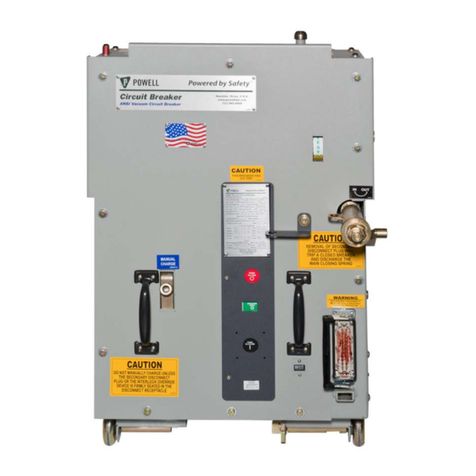
Powered by Safety®
ii
01.4IB.77020
PowlVac-ND®and PowlVac-NDA™Series 4
Vacuum Circuit Breakers
Contents
Ch 4 Installation .............................................................................................................24
A. receIvInG ........................................................................................................................................................ 24
B. hAnDlInG ....................................................................................................................................................... 24
c. StorAGe ......................................................................................................................................................... 25
D. plAcInG the cIrcuIt BreAker Into ServIce ........................................................................................................... 26
1) High Voltage Insulation Integrity ......................................................................................................................................26
2) Vacuum Integrity ...................................................................................................................................................................27
3) Control Voltage Insulation Integrity .................................................................................................................................28
4) Mechanical Operation Check .............................................................................................................................................29
5) Electrical Operation Check ..................................................................................................................................................30
6) Emergency Racking Mechanism Check (PowlVac-NDA™Series 4 Circuit Breaker Only) .....................................30
e. rAckInG proceDureS for poWlvAc-nD®SerIeS 4 cIrcuIt BreAker ........................................................................ 31
1) Prior to Inserting the Circuit Breaker into the Circuit Breaker Compartment .........................................................32
2) Inserting the Circuit Breaker to the Test/Disconnected Position ................................................................................33
3) Inserting the Circuit Breaker to the Connected Position ..............................................................................................34
4) Removing the Circuit Breaker from the Connected to the Test/Disconnected Position .......................................35
5) Removing the Circuit Breaker from the Test/Disconnected Position out of the
Circuit Breaker Compartment ............................................................................................................................................36
6) Remote Racking .....................................................................................................................................................................36
f. rAckInG proceDureS for poWlvAc-nDA™ SerIeS 4 cIrcuIt BreAker .................................................................... 37
1) Prior to Inserting the Circuit Breaker into the Circuit Breaker Compartment .........................................................37
2) Inserting the Circuit Breaker to the Test/Disconnected Position ................................................................................38
3) Inserting the Circuit Breaker to the Connected Position ..............................................................................................39
4) Emergency Racking In Procedure ......................................................................................................................................39
4) Removing the Circuit Breaker from the Connected to the Test/Disconnected Position .......................................40
5) Removing the Circuit Breaker from the Test/Disconnected Position out of the
Circuit Breaker Compartment ............................................................................................................................................41
6) Emergency Racking Out Procedure ..................................................................................................................................41
Ch 5 Maintenance ..........................................................................................................43
A. GenerAl DeScrIptIon ....................................................................................................................................... 43
1) Introduction ............................................................................................................................................................................43
2) Inspection and Cleaning ......................................................................................................................................................44
B. MechAnISM AreA ............................................................................................................................................. 45
1) Mechanical Operation .........................................................................................................................................................45
2) Lubrication ..............................................................................................................................................................................45
3) Closing Spring Removal .......................................................................................................................................................49
4) Slow Closing of Mechanism ................................................................................................................................................50
5) Mechanism Adjustments .....................................................................................................................................................50
6) Electrical Operation ..............................................................................................................................................................55




























